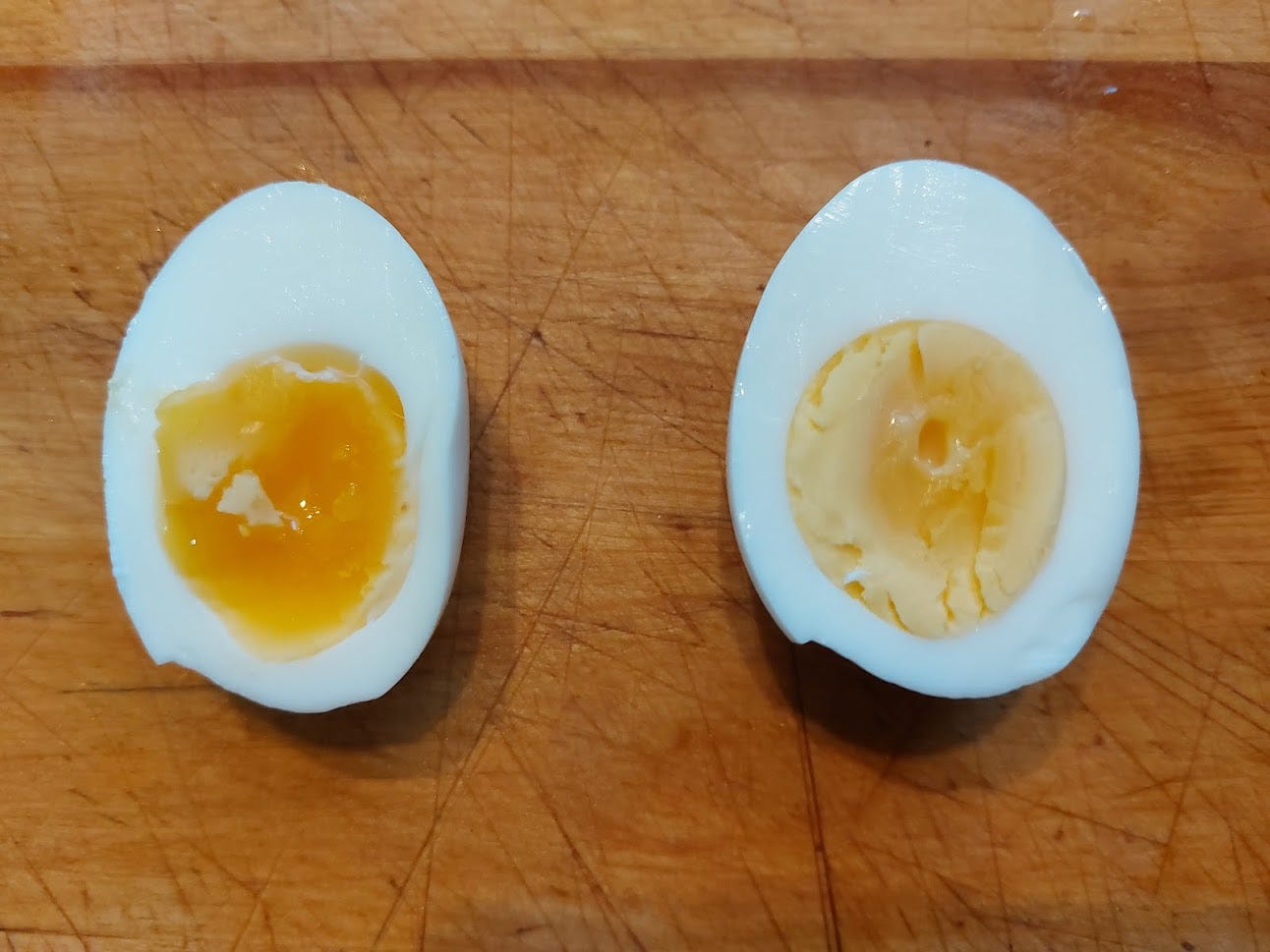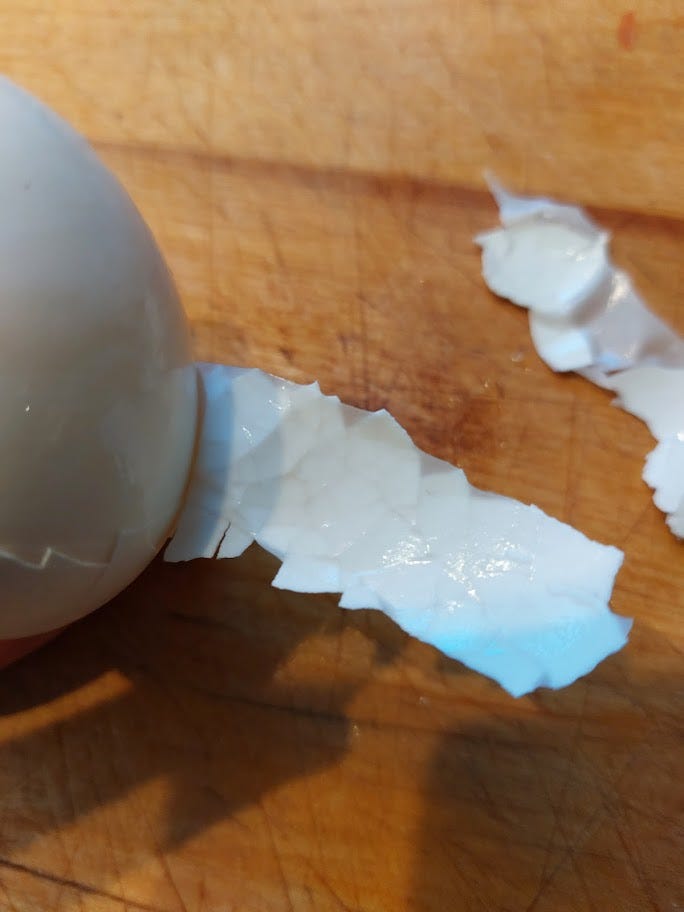I don’t believe in the idea of “superfoods” but if I did eggs would be pretty close to the top of the list. They’re incredibly versatile, cheap (relative to meat anyway) and have an impressive nutritional profile that’s hard to beat. Unless you are a vegan or allergic there is surely a form of egg that you’d be happy to eat.
That said, people can be incredibly fussy about how they like their eggs, which is part of the reason why most restaurant cooks despise the brunch shift: customers are a bunch of hungover caffeine-seeking Karens who are very particular about how their eggs are cooked. Mimosas don’t help the situation.
When it comes to eggs I prefer to make them at home – that way I can make them exactly the way I want. And one of the most exacting preparations is the boiled egg.
There is a lot of hocus-pocus nonsense about how best to boil an egg and, unfortunately, the answer is: it depends. It depends on the age of your eggs, whether they are room temperature or out of the fridge, and other variables of occasionally dubious importance.
But you want to make egg salad. Or have a high protein snack. You just want your eggs to be cooked, easy to peel, and not be tinged with green and smell like sulphuric farts. You aren’t asking a lot here.
Thankfully, the technique is very simple, easy to adjust to your personal taste, and needs very little more than a timer and a touch of patience. Other people have different methods but this is the one that I find produces the most consistent results.
A word about the eggs. Conventional wisdom is that older eggs are best for boiled eggs because they are easier to peel. This is true - older eggs lose some moisture, which increases the size of the air sac inside and also makes the egg a little more alkaline (fresh eggs have a neutral pH). Both make the egg somewhat easier to peel, but the air sac leaves you with a flat spot on your cooked egg (see the pictures below) and the egg is more prone to cracking on contact with the water. If shape is important to you (if you’re making deviled eggs, for example) then use fresher eggs, but just be a little more careful to follow all the steps and make a few extras in case you wreck one or two. Mistakes are the cook’s favourite treat.
You’ll need: large eggs, a pot, a slotted spoon or wire skimmer, some white vinegar, and water (of course). A tray of ice cubes is optional, but recommended.
Take your eggs out of the fridge to allow them to come to room temperature. If you’re in a hurry you can place them in a bowl or sink full of very warm tap water. If you drop fridge cold eggs into boiling water you’ll almost guarantee that the eggs will crack.
Bring a pot of water to a rolling boil. The pot should be large enough to hold the eggs in one layer, and the water deep enough to cover them by a couple of inches.
Add a splash (a tablespoon or two) of white vinegar to the water. The acid in the water will help coagulate the egg white if the shell does crack. (Hey, that’s the same reason we put vinegar in our egg poaching water!)
Carefully lower your eggs into the boiling water.
Turn the heat down so that you have a boil, but not a wild rolling boil. Too much churning action could cause your eggs to crack, and the high heat will toughen your egg white, particularly if you choose a longer cooking time.
Set a timer for between 6 and 11 minutes. Less than 6 minutes will put you in runny egg white territory, and longer than 11 minutes puts you at risk of the green/grey yolk ring. The egg on the left cooked for 7 minutes, and the one on the right 10 minutes. There’s plenty of room to adjust to your liking.
While your eggs are cooking, fill your sink with several inches of cold water and dump in a tray of ice cubes. If you’re like me and forget to make ice, fill the sink with the coldest water you can run out of your tap - it will be fine. I prefer the sink to a bowl because it holds a larger volume of cold water and thus won’t heat up as quickly, especially when I forget to make ice.
As soon as the timer dings, scoop out your eggs and plunge directly into the icy sink. (You’ve scrubbed your sink recently, haven’t you?)
Take a nap. Walk the dog. You want your eggs to fully cooled. Getting them fully cooled is key to easy peeling.
When your eggs are cool, tap them against your counter or cutting board, then roll them under your palm to crack around the circumference. Be gentle, especially if you’ve used a shorter cooking time. The egg white is still cooked, but notably more delicate than a longer cooked egg.
If your shells are sticking (they shouldn’t, but it does happen), try peeling them under running water, and try to get the water running between the egg white and the thin shell membrane. Once you get the membrane to come away the little shell bits will come away too.
And what to do with your bespoke boiled eggs? Egg salad is an obvious choice, and the key to an eggselent egg salad is to balance creaminess with crunchiness and a hint of acidity. Salt is mandatory and mayonnaise is standard, but chopped celery, pickles (and pickle juice!), mustard, lemon, fresh tomato, and all the fresh tender herbs are fair game. Try chopping your eggs instead of mashing them - it gives them a high tea spirit rather than a cafeteria vibe.
If you need a recipe Smitten Kitchen’s version with grainy Dijon and pickled celery is utter perfection. Or double-down on the decadence and simplicity by channelling your inner Scandinavian with some munavoi (Finnish egg butter), though your doctor may not approve.
Or just eat an egg. A sprinkle of salt, a grind of pepper and maybe a a dash of smoked paprika or a bit of celery salt. Simple, satisfying, and while it may not be a superfood it sure is good.











I love hard boiled eggs!